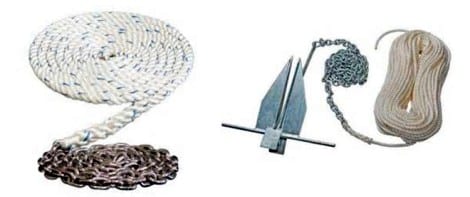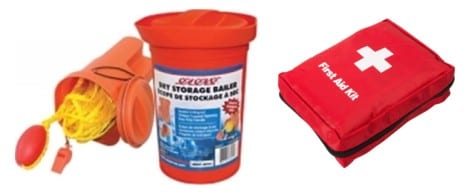 By Bob Currie, Vessel Examiner
By Bob Currie, Vessel Examiner
United States Coast Guard Auxiliary Flotilla 081-06-08
USCG Auxiliary Flotilla 081-06-08 is based at Coast Guard Station Galveston. The Auxiliary’s vessel examiners perform safety checks on all types of recreational boats. The list of equipment required by federal law is very minimal; however, the Coast Guard has several recommendations for consideration by the prudent and safe recreational boater. Many of the recommendations for recreational boaters are actually required of commercial vessels.
Dewatering Device
A dewatering device is a piece of equipment designed to help bail out or pump out a boat. It isn’t required, but strongly recommended. It may be the only way to deal with a situation in which the vessel is taking on water. All boats should carry at least one effective manual dewatering device such as a hand operated pump, a bucket, or a large plastic bottle with the bottom cut off that can serve as a water scoop. This recommendation is in addition to any electrical or manual bilge pump that may have been installed on board. Installed bilge pumps should be periodically tested. Pontoon boats or vessels that do not have compartments vulnerable to flooding should carry at least one dewatering device in case they are called on to help other boaters. If you ever discovered after launching that you forgot to put in your plug, you will quickly realize the value of having additional help for that automatic bilge pump.
Mounted Fire Extinguishers
Fire extinguishers are not required to be mounted. It is strongly recommended that fire extinguishers be mounted in locations that are visible and readily accessible. Before a vessel gets under way, boat operators should show all crewmembers and passengers where fire extinguishers are located and how to operate them. The Coast Guard responds to vessel fires quite often. It is recommended that you have more fire extinguishers than required.
Anchor and Rode
Anchors also are an important piece of safety equipment to keep the boat from drifting into danger or running aground. Boaters should make sure that their boats are equipped with an anchor of the appropriate type, size and weight for their vessel, as well as the kind of bottom that prevails in the waters in which they will be operating, such as sand, mud, rocks, etc. The anchor should be attached to a 3-6 foot length of galvanized chain, which resists abrasion better than a fiber line would and which helps to hold the anchor flat on the bottom so it can dig in more effectively. The chain, in turn, is attached to the anchor line. Together, they are known as the anchor rode.

The anchor rode should be long enough to enable the boater to pay out line at least seven times the likely depth of the water in which the vessel will be anchoring. Ideally, line should be made of nylon, whose elasticity enables it to stretch with the motion of the sea and helps reduce the load on both the anchor and the vessel. In choosing a spot in which to drop anchor, the operator should pick an area that offers maximum shelter from weather elements and boat traffic. Choose a bottom consisting of sand or mud which makes it more likely that the anchor’s flukes will dig in and hold. The anchor line should be paid out at least five to seven times the distance between the anchor chock at the vessel’s bow and the bottom. The operator and anyone who is going to help with the anchor should know how to properly set and weigh anchor. Different type anchors require different methods.
The anchor and rode become a life saving item whenever a boater is caught off guard by a change in the weather, which can cause wave action too strong to navigate. In this instance, a good anchor and rode can mean the difference between riding out the storm and sinking. Sometimes your only option is to anchor and play out enough anchor line so that the boat rides stationary in the water instead of being tossed about by the waves. Some experienced boaters carry more than one anchor, with a heavier anchor being reserved for such emergencies.
First Aid Kit and Rescue Gear
Boaters should carry a first aid kit properly sized and appropriate for the type of boating they do, such as on small lakes, coastal waters, offshore, or extended cruising. Adequate kits of all sizes can be purchased at boating supply stores or online. Boaters should also consider adding medicines or medical equipment that may be needed by crew members or passengers who have special medical conditions, such as allergies. Experienced fishermen know better than most boaters of the value of a well-supplied first aid kit. Although duct tape will serve to cover or close a gaping wound from a filet knife, wouldn’t you rather have a good roll of medical tape and antiseptic?
Operators also should consider carrying rescue equipment designed to help pull someone out of the water, such as extra life jackets; a life ring (or horseshoe buoy) with a polypropylene line tied to it; a line throw bag; or, on a sailboat, a rescue strop that can be wrapped around the chest of a person in the water so he or she can be hoisted aboard. Attaching a line to a life ring enables those on board to retrieve the device if it is tossed too far for the person in the water to reach; it also helps pull the person back to the boat once he or she grabs onto the life ring. The operator should always make sure that the vessel’s propeller is stopped when a person in the water is near the boat; the best way to do that is to shut off the engine while the person is close by. This extra equipment is often referred to as a Man in Water (MIW) kit. The time to let your passengers know about this equipment is before you sail. Everyone should be apprised of the extent of and location of all safety equipment aboard before leaving the dock.

Visual Distress Signals on Inland Waters
Boaters operating on inland waters or locations where visual distress signals are not required should consider keeping them on board to enable them to signal other vessels or persons on land in case of emergency. Vessel owners should determine what types of signals they need based on the area and conditions in which their boats will be operating.
For more information on boating safety, please visit the Official Website of the U.S. Coast Guard’s Boating Safety Division at www.uscgboating.org. Questions about the U.S. Coast Guard Auxiliary or our free Vessel Safety Check program may be directed to me at [email protected]. I am available to perform free Vessel Safety Checks, and I will come to your location to perform them. SAFE BOATING!
[11-13-2017]

 Posted in
Posted in 























